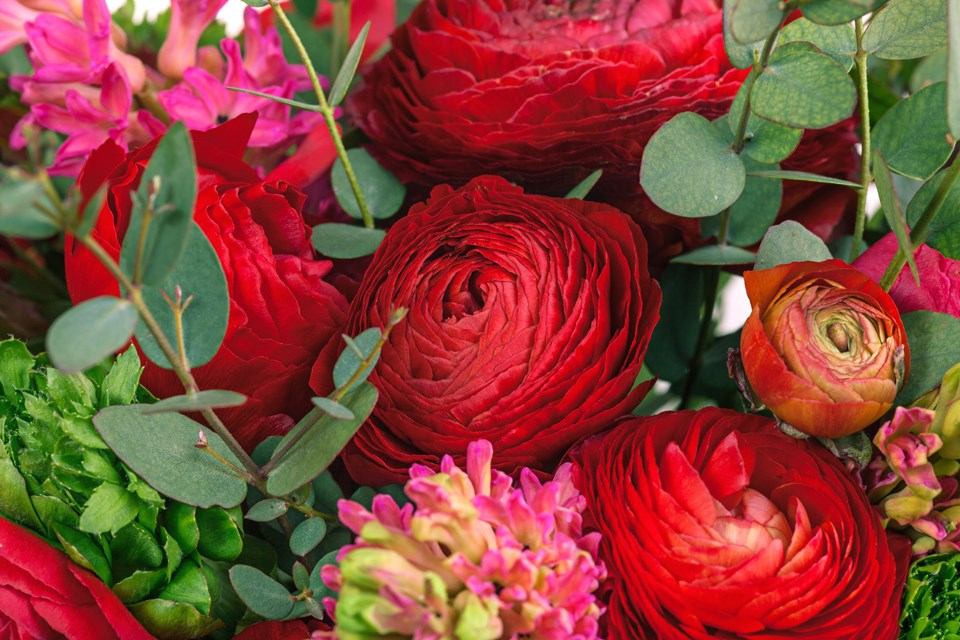One of the first reasons that I started to garden when I was younger was that I wanted to grow beautiful flowers. That passion has never left me. The first time I saw a ranunculus flower: I thought it was a rose. The delicate, multi-petaled, tight inflourescence was very similar to a slightly expanding rose bud or a miniature peony.
Ranunculus (Raununculus asiaticus), also sometimes referred to as Persian buttercups, are native to the island of Crete and Southwest Asia. ‘Ranunculua’ in Latin refers to ‘little frog’ which refers to the fact that, like frogs, the ranunculua species is often found near water. Ranunculus was first introduced into Europe at the same time as the anemone and the tulip, during the 16th century.
Ranunculus asiaticus is a perennial in zones 6-10 however, in the Prairie growing region, ranunculus is treated as an annual. Ranunculus plants grow from underground storage organs known as corms. Ranunculus plants and corms are not tolerant to frost. For ranunculus plants to bloom during the Prairie summer, corms must be started indoors. It can take 12-16 weeks for ranunculus plants to bloom from planting time.
On the Prairies, plant corms indoors in early March for June/July blossoms. Corms will initially look dry and whithered (like dried-up little octopus). Soak corms in water for 1-3 hours before planting: corms ready for planting will be plump and increase in size. Immediately after soaking, plant corms in moist planting media, about 4-5cm deep, with the ‘claw-like’ parts of the corm facing downward. Keep the potting media moist until sprouts emerge. Once the sprouts emerge, the media can be allowed to dry out between waterings. Ranunculus are cool-season flowers that prefer temperatures of 15-20°C but will grow in warmer temperatures.
Ranunculus are available in various colours: white, yellow, peach, pink and dark purple. Each plant produces multiple blossoms. Transplant ranunculus plants only after all danger of frost has passed. Plants should be spaced 25cm apart in the garden. Harden off plants for several days before planting out. Plant ranunculus plants in well-worked, fertile, well-draining soil in full sun. Keep the roots moist but don’t overwater. Ranunculus plants can be susceptible to powdery mildew so provide ample airflow around plants and avoid shady, damp locations.
Ranunculus flowers are excellent cut flowers. Stems can be 20-40cm tall, depending on the cultivar. The best time to cut ranunculus flowers for cut flowers is when the bud is coloured but still closed. Ranunculus flowers cut at this stage will easily last 10-14 days in a vase at room temperature: replace the water in the vase every 3-4 days with fresh water. Cutting spent flowers from the plants outdoors in the garden will encourage more blooms throughout the growing season. Ranunculus flowers hold their colour when they are dried and are often used as dried flowers. However, dried ranunculus flowers are very delicate and must be handled with care.
To save ranunculus corms from one year to the next, dig up the corms as soon as the plants have died back: this may happen even before fall frost as ranunculus plants do not grow well in extended hot temperatures over 30°C. Corms that are left in the ground (even if the ground is not frozen) may provide food for gophers and voles. Gently remove as much soil from the corms as possible without damaging the corms. Allow the corms to dry until they become hard and crisp. Place the corms in a paper bag and store them in a dry, cool location indoors until it is time to soak them in water again for next spring’s planting.
For those gardeners who have pets in their yard, be aware that all ranunculus species are poisonous to people and pets. If humans or pets chew on the plants, blisters form on the face and lips. The oil in the plant is also an eye irritant. The good news is that ranunculus give off an acrid taste that usually means that they are left alone by all creatures.
If you are interested in trying to grow ranunculus this season, now is the time to order your corms. Check out websites and seed catalogues that sell summer flowering corms like gladiolas; chances are that they may also have ranunculus corms for sale.
Happy Gardening!.
For more information on ranunculus and other cut flowers, come meet Bailey Dueker a flower farmer at Boondock Flower Farm, north of Biggar on Wednesday, Feb. 26, at 7 p.m. at Lakewood Civic Centre, Cliff Wright Auditorium.
This column is provided courtesy of the Saskatchewan Perennial Society (SPS; [email protected]). Check our website (www.saskperennial.ca) or Facebook page (www.facebook.com/saskperennial) for a list of upcoming gardening events.




